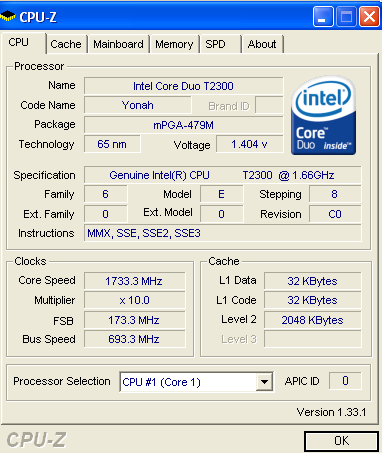System setup and notes
Hardware and Software
Test Platforms
| System | rock Pegasus 330 | rock Pegasus DDO | ASUS A6JA laptop |
| Processor(s) | Intel Centrino Duo T2300 (1.67GHz, 2MB L2 cache, 667MHz FSB, dual-core @ 1.73GHz | Intel Pentium M 750 (1.86GHz, 2MB L2 cache, 533MHz FSB - single-core) @ 1.94GHz | Intel Centrino Duo T2500 (2.0GHz, 2MB L2 cache, 667MHz FSB, dual-core |
| Mainboard | Intel i945PM Napa | Intel i915PM Sonoma | Intel i945PM Napa |
| Memory | 512MByte (2x256MB) Samsung PC4200 DDR2 SODIMMs | 512MByte (2x256MB) Samsung PC4200 DDR2 SODIMMs | 2GBytes (2x1024MB) Samsung PC4200 DDR2 SODIMMs | Memory timings | 4-4-4-12 @ DDR2-533 | 4-4-4-12 @ DDR2-533 | 4-4-4-12 @ DDR2-667 | Graphics Cards | Intel 945GM (Integrated) | ATI Mobility RADEON X700 128MB | ATI Mobility RADEON X1600 256MB |
| Graphics Card driver | Intel 6.14.10-4436 | ATI 8.183.4-050212a-021287C | ATI 8.183.4-051031a-027919C |
| Disk drive(s) | Fujitsu 80GB 5,400RPM | Hitachi 80GB 5,400RPM | >Hitachi 100GB 5,400RPM |
| Screen | 13.3-inch WXGA (1280x768) | 15.4-inch WSXGA (1600x1050) | 15.4-inch WXGA (1280x800) | Operating system | Windows XP Home SP2 | Windows XP Home SP2 | Windows XP Pro SP2 | Price | £888 inc. VAT | £999 inc. VAT | £1499 inc. VAT |
Benchmark Software
HEXUS Pifast BenchmarkScienceMark 2.0
DivX 6.1 encoding benchmark
CINEBENCH 2003 multi-CPU render
HEXUS.in-house MP3 Encoding Benchmark using LAME 3.97a (Intel HT compiler) - 701MB WAV
KribiBench v1.1
Simpli Software's HDTach 3.0.1
Notes
We'll be taking a look at the performance numbers from rock's thin-and-light Pegasus 330 in relation to two more-expensive laptops that feature an Intel Pentium M 750 (Dothan) and Intel Core Duo T2500 (Yonah) CPUs, respectively. Both rock laptops feature a 5% mains-powered overclock; performance for free, effectively.Due to the '330's thin-and-light design and integrated graphics we will not be running our usual gaming suite.

We suppose this CPU could be referred to as a Yonah T2350. rock definitely has a competitive advantage by raising clockspeeds by 5%, accessed by an option in the BIOS. Let's now see how it performs against some stiff competition.









